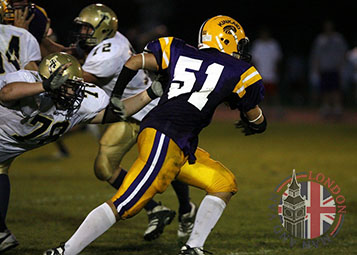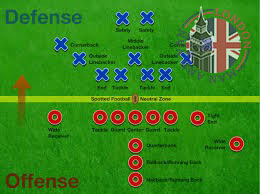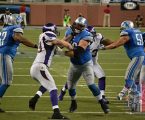
A look at the NFL defensive game
While the offensive game in the NFL is more appealing to the public, the defense is perhaps even the more important of the two. On offense we get to see long passes and breathtaking catches. We see long runs, broken tackles, stiff arms and just an array of routes being run. Most of the highlights consist of offensive plays but specialists say that the defense is the absolute backbone of every team. In fact is believed that defenses win championships. Besides a good strong hit or an interception can easily turn the tide of a game. This is why we will look into the responsibilities of each defensive position on the field. We have:
- Defensive linemen
- Linebackers
- Cornerbacks
- Safeties
We will start from the inside out. The defensive linemen are positioned at the line of scrimmage. Their goal is to rush the passer (the quarterback) and to also stop the run as quickly as possible. Both tasks are very hard and this is why sacks are an impressive stat for every player. Just to put it in perspective – if a defensive end (these are the players on the edge of the line of scrimmage) gets more than 10 sacks in a season he is considered to have had a good season. With 16 season games and about 70 plays each game you would think that 10-15 sacks is easy to achieve. Not at all – it’s impressive. The defensive tackles’ job is to fill the holes in the middle of the line and stop the run. These fellas are usually huge and they can rarely get to the quarterback. They simply need to put pressure on the offensive line and try to stop the running back. The defensive line can also try and deflect passes when it is too late to sack the quarterback.
 The linebacker position is perhaps the most versatile and difficult position to play on the defensive team. These guys really need to be able to do it all. They are big and strong but are also required to be quick and to jump high. Not only that but they need to possess the ability to “read” the offense and try to guess what type of a play the opposing quarterback has called. Linebackers help the D-line by further filling holes through which running backs sneak. They also need to be able to blitz. Blitzing is a defensive scheme is which linebackers to not fall back into coverage but instead assist the D-line in rushing the quarterback thus outnumbering the offensive line, possibly overwhelming it and thus sacking the quarterback. This is a high risk – high reward scheme in which you leave areas wide open in attempt to quickly end the play before a pass is launched. Linebackers are also required to sometimes cover tight ends. This is because they have similar body types to the ones of the TEs. This also means that they need to have good hands in order to eventually intercept passes. A linebacker must also do QB spying. This is a type of defensive responsibility in which the linebackers watch for quarterback runs. This position is usually divided in three: Middle linebackers, Left and Right outside linebackers. The outside linebackers are usually the ones to try to blitz the quarterback the most. Middle linebackers stop runs and fend off pass plays.
The linebacker position is perhaps the most versatile and difficult position to play on the defensive team. These guys really need to be able to do it all. They are big and strong but are also required to be quick and to jump high. Not only that but they need to possess the ability to “read” the offense and try to guess what type of a play the opposing quarterback has called. Linebackers help the D-line by further filling holes through which running backs sneak. They also need to be able to blitz. Blitzing is a defensive scheme is which linebackers to not fall back into coverage but instead assist the D-line in rushing the quarterback thus outnumbering the offensive line, possibly overwhelming it and thus sacking the quarterback. This is a high risk – high reward scheme in which you leave areas wide open in attempt to quickly end the play before a pass is launched. Linebackers are also required to sometimes cover tight ends. This is because they have similar body types to the ones of the TEs. This also means that they need to have good hands in order to eventually intercept passes. A linebacker must also do QB spying. This is a type of defensive responsibility in which the linebackers watch for quarterback runs. This position is usually divided in three: Middle linebackers, Left and Right outside linebackers. The outside linebackers are usually the ones to try to blitz the quarterback the most. Middle linebackers stop runs and fend off pass plays.
The cornerbacks are the fittest defensive players and they also have great speed. This is because they are responsible for covering the wide receivers. These defenders need to think like a receiver if they want to stop one. Actually many of them start as wideouts in college or high school and then move to the cornerback position. They need to be familiar with the style of play of their opponents and need to be good at guessing routes. If a receiver gets enough separation from their personal defender then they will surely be targeted and will catch the ball. Cornerbacks also blitz sometimes and this can really get the offensive line unprepared. This position is most likely to make an interception and to complete the coveted “pick 6”. This is an interception where the defender not only catches the ball but manages to return it for a touchdown right away. Many cornerbacks never get to experience this feeling.
 Safety is much needed. It is important in all aspects of life such as removals in Lambeth, house cleanings and man and van services. The safeties are also a very versatile defensive position in the NFL, however. There is usually two of them but often there is only one. There are strong safeties and free safeties. They stay behind the linebackers and the cornerbacks and defend the deep balls. Safeties can, however, be required to guard shallow zones or even blitz depending on the defensive scheme. The free safety is more of a cornerback – quicker and assists in guarding receivers. The Strong safety helps the linebackers and is known for being able to hit hard. Many good cornerbacks as they get old become safeties because the position requires less agility and acceleration while still requires the ability to defend passes well.
Safety is much needed. It is important in all aspects of life such as removals in Lambeth, house cleanings and man and van services. The safeties are also a very versatile defensive position in the NFL, however. There is usually two of them but often there is only one. There are strong safeties and free safeties. They stay behind the linebackers and the cornerbacks and defend the deep balls. Safeties can, however, be required to guard shallow zones or even blitz depending on the defensive scheme. The free safety is more of a cornerback – quicker and assists in guarding receivers. The Strong safety helps the linebackers and is known for being able to hit hard. Many good cornerbacks as they get old become safeties because the position requires less agility and acceleration while still requires the ability to defend passes well.
All of the positions mentioned above are usually asked to one of two types of defense on every down. Zone defense means that each defender has a zone to cover and as an offensive player moves through a certain zone, the defender picks him up. If the offensive player leaves that zone he become a concern of the next defender and so on. Zone defense is good against slower offenses and can make the life of a quarterback tough. Man to man defenses employ a strategy where one defender guards one offensive player. This type of defense requires great speed and attention in order for the defender to be able to keep up. By using deceptive routes, receivers and tight ends can easily get open and this is why man to man defense can often suffer against the pass. It stops the run well, however, because a defender is assigned to cover the running back. Cornerbacks also leave their men in the case of a rush and assist in bringing down the ball carrier.
About author
-

-
Jeremy Oliver
Previously serving as a logistics coordinator, Jeremy's comprehensive understanding of the industry gives him the ability to translate complex procedures into easy-to-understand blog posts. He has a particular knack for tackling the intricacies of London's removals scene, from the congested roadways to the unique challenges of navigating historic neighborhoods. As an authentic Londoner, Jeremy combines practical knowledge with his inherent love for the city, offering readers not only information on man with van removals but also local insights and valuable tips.


